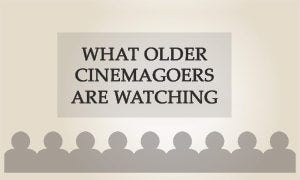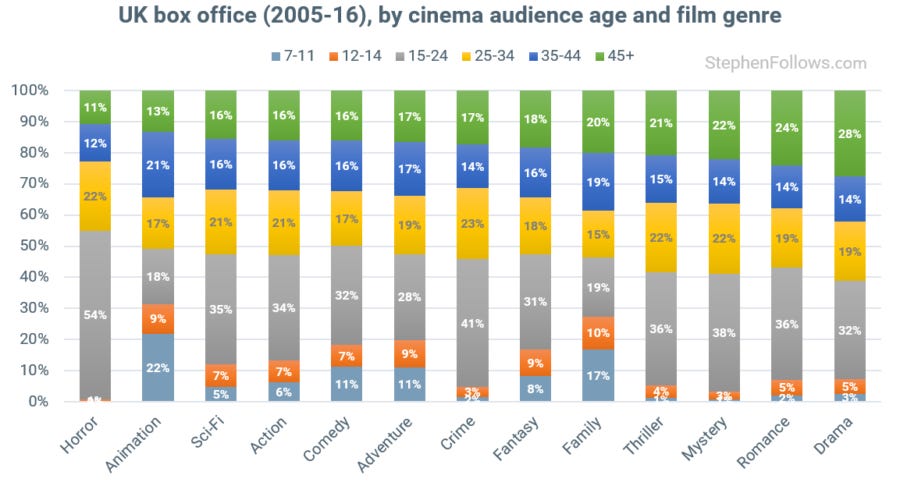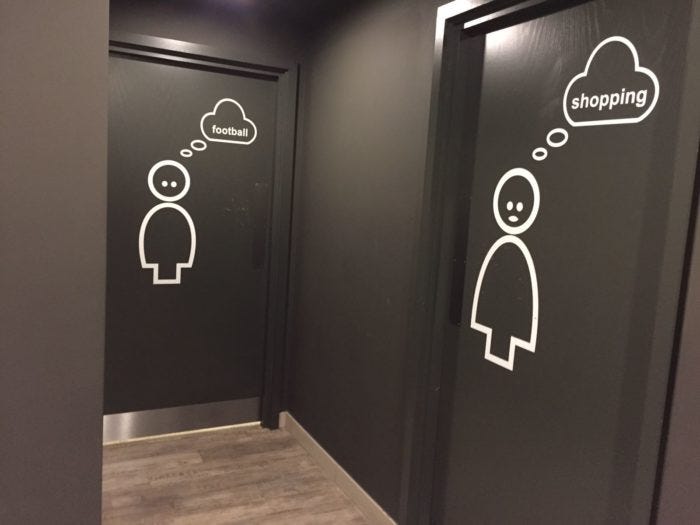What films are older cinemagoers watching?

Following the trends article at the start of the year, I have been receiving requests for more details on some of the topics I covered. One of the six trends I noted was the ageing cinema audience, which led to a number of people asking what types of movies older audiences turn out for.
So today I'm going to show which movies are favoured by older audiences, who's in them and the journey we take in our film choices as we age.
Pop quiz, hot shot
Before I dig into the detail, I wanted to set you a little challenge. Each year, the BFI's Statistical Yearbook reports which movies had a significantly above-average attendance by different types of people.
Your task is to match up each of the six groups of movies below with one of the following age segments: aged 7-14, aged 15-24, aged 25-34, aged 35-44, aged 45-54 and aged 55+.

Try it out - it's not as easy as it first appears, and the answer reveals something important about cinema audiences (see - we can have fun and learn at the same time!) I'll reveal the answer at the bottom of this article.
The genres older cinemagoers are watching
Many institutions within the industry conduct audience research and exit polls, but sadly these often remain private or behind expensive paywalls. Fortunately, there are a couple of free public places where we can find data to learn about the age of the UK cinema audience.
I've already mentioned the BFI (who also used to conduct exit polls, which include age data) and the other is Pearl and Dean. They have a microsite aimed at cinema advertisers, and within that they provide audience data on the age, gender and social class of cinema-goers. I'm not going to look at social class of cinema-goers today, but if you want me to write about it in the future, leave a message in the comments or drop me a line.
Using this data, I was able to look at 662 movies released in UK cinemas between 2005 and 2016. I matched up the UK box office gross and split the data by genre.

The oldest age group here (i.e. those aged 45 and over) are best represented among dramas (where they make up 28% of the box office), romance (24%) and mystery (22%). Drama has the oldest audience overall, with over 60% of cinema-goers who watch dramas being older than 25.
Horror is an interesting genre as it has almost no audience under 15 (understandably, due to BBFC ratings) but also performs poorly with older audiences. Over half of all the people who see horror movies in the cinemas are 15 to 24 years old.
Other genres which perform poorly with older audiences are animation (13%), and sci-fi (16%) and action (16%). It appears that many of the choices of older audiences can be summed up by looking at how close they are to the real world. The further removed a movie is from reality, the less likely older audiences are to go and see it in the cinema.
The films most popular with older cinema-goers
The movies with the highest percentage of older audience members (in this case that means over 45 years old) were Sweet And Lowdown, Mr. Turner, The Second Best Exotic Marigold Hotel, Philomena and The Queen.
[table id=93 /]
Dentures fill the screen

I focused on the 76 films where the 45+ age segment accounted for at least half of the cinema audience. There is no doubt that the true star of this audience group is Dame Judi Dench, who appears in 9% of movies this group (i.e. seven appearances).
Other popular stars included Cate Blanchett (5 appearances), Meryl Streep (4), Maggie Smith (3), Ralph Fiennes (3) and Jim Broadbent (3).
What ageing looks like for our film choices
We can also see what ageing looks like in the movies we choose to go and see in the cinema. The images below show the movies that were most popular with men and women, organised so the ones with the youngest audiences were on the left and the oldest on the right.
The male choices seem more focused on physical prowess and power whereas the female choices focus on relationships; starting out kissing boys (Down To You), then stripping men (Magic Mike) and ending up with masochistic, melancholic sex (The Piano Teacher).

I should note that these movies do not represent the most popular films, but rather than the 'most skewed' by gender and age. For example, the cinema audience for Any Given Sunday was heavily male (75% of the audience) and almost entirely young (91% were 15-24 years old). By contrast, The Piano Teacher was 69% female and 63% were over 45 years old. Some movies were heavily skewed in age but not gender, such as Mr Turner which was favoured by older audiences (91% were 45+) but with a fairly even gender balance (54% female), which is why it's not made it into the image above.
The answers to the pop quiz
If you took a few moments to answer the quiz at the start of the article you may have struggled a bit. I have presented this question to a number of audiences over the years, including in primary schools, in my annual lecture at the NFTS and to industry professionals. No matter the environment (or how confidently people start the matching process), they often come undone when trying to understand why there are two groups seemingly suitable for the 7 to 14-year-old segment (i.e groups C and E).
The people who rarely have a hard time answering this question are those with young children (typically in the 35-44 age bracket). They look back wistfully at the days when they could choose what movies they went to see in the cinema.
So here are the answers:

Epilogue
I'm often torn when presenting data of how certain groups of people act. On the one hand, I'm only presenting data and the numbers are often clearly pointing to what people are choosing. On the other hand, it's reporting like this that reinforces stereotypes and prevents our understanding of people's tastes from evolving.
Cinemagoers' current choices could be a result of what is being supplied and marketed by the industry. For example, the recent success of female-focused mainstream blockbusters has shown that the female audience were previously underserved and when they're offered more targeted options, they take them.
The film industry is often among the last to notice the shift away from stereotypical audience groups. That being said, they are still better than some. Last week, I was in Birmingham to give a talk to the National Trust and I stayed in a hotel with the following images on the toilet doors:



